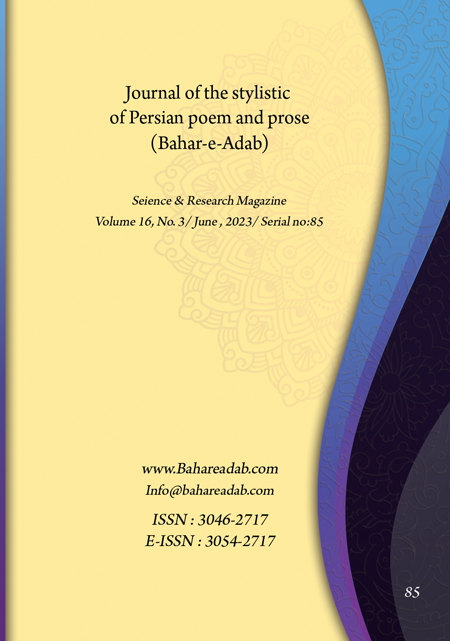- Count View : 327
- آدرس کوتاه شده مقاله: https://bahareadab.com/article_id/1455
- کد doi مقاله: Doi: 10.22034/bahareadab.2023 .16 .6841
Journal of the stylistic of Persian poem and prose
volume Number 16،
number In Volume 3،
،
issue Number 85
A look at the motifs and themes of the persian poems of Arasbaran region
Maryam Beyrami , Maryam Mohammadzadeh (Author in Charge), Reza Aghayari Zahed
Abstract
BACKGROUND AND OBJECTIVES: Arasbaran region, in East Azarbaijan province, has many poets in whose poetry several motifs are repeated in different periods. In this article, with the aim of introducing the literature of this region and a general look at the place of poetry in it, the motifs and themes of the Persian poems of six of its poets from the return period until today have been examined.
METHODOLOGY: The collection of information has been done by the library method and the method of writing the article is descriptive-analytical. The statistical community of the research includes the Persian poems of seven poets of Arasbaran region, Abolqasem Nabati, Abbas Barez, Salek Ahari Tabrizi, Morteza Mousavi, Imam Virdi Samani, Ismail Soltani and Hossein Doosti.
FINDINGS: Lyrical, mystical, moral, and religious themes are among the motifs and themes of classical Persian literature, and social themes, patriotic poems, Islamic revolution, and holy defense are among the contemporary themes in the poetry of the poets of the region. In lyric poetry, there is a traditional view of love and the beloved. In addition to the motif of love, themes of sadness and pride are repeated. In the mystical and moral poetry, according to romantic mysticism, there are themes of Randy, Qalandari, criticism of hypocritical asceticism, condemnation of the world and advice on moral standards. In the motif of religion, the moqbat of the pure Imams, especially the manqebat of Imam Ali has found a stylistic feature. In social poetry, there is a criticism of the Pahlavi society, a description of oppression and tyranny, poverty and social disorder. The description of the homeland, the praise of the birthplace, the region of Arasbaran, the description of the Islamic revolution, the praise of Imam Khomeini (RA), the condemnation of the enemies, and the description of the martyr are some of the revolutionary poems of these poets.
CONCLUSION: In the poetry of Arasbaran region, classical and contemporary themes are repeated with lyrical, religious, mystical, educational and Islamic revolution motifs and themes. Arasbaran poets have turned to new themes along with the changes in themes in contemporary poetry, but they still pay attention to the motifs of classical poetry.
Keyword
motif
, theme
, Arasbaran
, love
, religion
, mysticism
, Islamic revolution.
- Abbaszadeh, Saeed. (1996). Sima –ye- Arsbaran (Ahar), The Land of Believers, Qom: Cultural Institute and Nahavandi Publications.
- Ahari Tabrizi, Salek. (2018). a collection of poems by the Salek Ahari Tabrizi, edited by Reza Hamraz, Tabriz: Qalan Yurd.
- Dadd, Sima. (2016). Dictionary of Literary Terms, Tehran: Morvarid.
- Doosti, Hossein. (1991). literary types, third edition, Mashhad: Astan Quds Razavi.
- Doosti, Hossein. (2013). Aftermaths of Arsbaran Earthquake, compiled by: Abolfazl Qasim Baglo and Hossein Doosti, Tehran: Mobatkeran, Pishrovan.
- Doosti, Hossein. (2014). Elegy literature in Arasbaran region, Tehran: Safir Ardahal.
- Doosti, Hossein. (2017). a distinguished master of Iran's national poet, Ahar: Shamisa.
- Doosti, Hossein. (2021). The Mystery of Love (a collection of poems), Ahar: Shamisa.
- Mirsadeghi, Jamal. (2001). Story Elements, Tehran: Sokhan.
- Mousavi, Seyyed Morteza. (1984). Sotak Poetry Collection, Tabriz: Safa Printing House.
- Nabati, Abulqasem. (2012). Divan Farsi Nabati, edited and corrected by Ali Mollazadeh (Mehraban), Tabriz: Nabati Tabriz.
- Nasser, Mohammad. (2003). The evolution of theme and meaning in contemporary poetry, Tehran: Neshane.
- Parsansab, Mohammad. (2008). "Motif, definitions, types, functions and...", Literary Criticism Quarterly, No. 5, pp.7-40.
- Samani, Imam-Virdi. (2013). Ojaghi poetry, poetry collection of contemporary poets, collection of Imam-Virdi Samani, Tabriz: Bahardokht.
- Shafi'i-Kadkani, Mohammad Reza. (1993). "Literary Genres and Persian Poetry", Rushd Journal of Persian Literature Education, No. 32, pp. 4-9.
- Soltani, Ismail. (2001). Sharh Hejran, Tabriz: Forough Azadi.
- Taghavi, Mohammad and Dehghan, Elham. (2008). "What is a motif and how is it formed?" Literary Criticism Quarterly, No. 8, pp.7-31.

